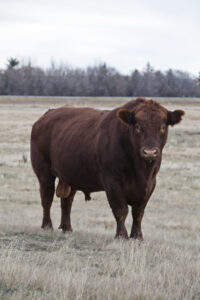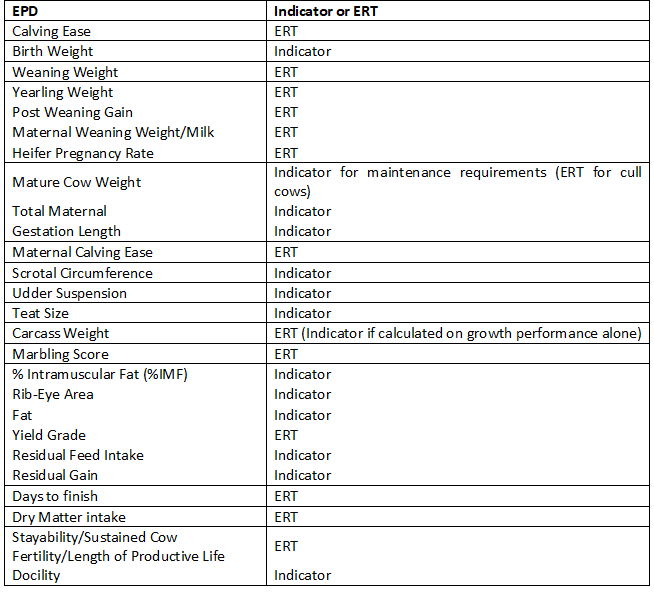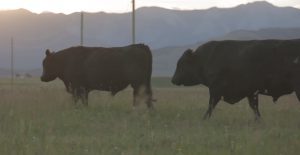Bull Selection: Using Economically Relevant Traits

Editor’s note: The following is part three of a four-part series that will help you to evaluate different breeding programs, which bulls are optimal for your herd, and how much they’re worth. (See part one and part two).
Sire selection often encompass a variety of factors such as how well a bull fits into the breeding objectives of your operation, breed, conformation, pedigree, birthweight, and price. Recent surveys from western Canada in 2014 and 2017, Ontario in 2015/16, northern Ontario and Quebec in 2015/16, and Atlantic Canada in 2016/17 production years asked respondents to rank their top bull selection criteria. There wasn’t a lot of variation between regions with breed, conformation, pedigree, birth weight, individual performance, expected progeny differences (EPDs), and temperament all being highly ranked by survey participants.
Some of the criteria, like breed, may influence sire selection due to the desire to capture heterosis or breed complementarity effects. Conformation is important for longevity and ensuring the bull gets the job done during the breeding season. Having a bull with a desirable temperament makes everyone’s lives easier, especially if there are children or older individuals involved in the operation. Individual performance and birth weight may give some indication of how the bull’s progeny may perform, but a better indicator in this area is actually the bull’s EPDs. Response to selection using EPDs is 7-9 times more effective than selecting based on individual animal performance7.
The question is, how well do these various selection criteria translate into profit?
Answering this question means taking a look at your operation.
- What are your breeding/marketing goals?
- Which traits affect the profitability of your operation?
- What constraints does your operation have (forage resources, labour, etc.)?
- Do you raise your own replacements or purchase them4?
Once those questions are answered, there are likely a number of traits you have identified as important to your operation.
While a number of data sources exist to help you evaluate the contribution of a potential herd sire to improving the traits of interest, it is important to recognize whether the traits you have identified are indicator or economically relevant traits. Good record keeping is crucial to determine whether or not progress is being made in the traits you have identified as important to your operation’s productivity and profitability.
Economically relevant traits (ERTs) or Indicators?
Economically relevant traits (ERTs) are those that are directly associated with a source of revenue, or a cost. Not all EPDs represent ERTs – instead they use a related (or indicator) trait to estimate the ERT.
One of the best examples is birth weight. Decreasing a bull’s birth weight by 5 lbs does not have any associated income or costs, but is often used as a bull buying criteria in an effort to reduce calving problems.
The actual ERT in this case is calving ease, as an increase in calving problems will reduce calf survival (less calves to sell), incurs higher labour costs (pulling calves, or more time spent monitoring), and delays cow rebreeding (younger and lighter calves to sell next year). Birth weight is an indicator trait, and although related to calving ease, birthweight only explains 36-64% of genetic variation between animals in calving ease1,2
Similarly, ultrasound for carcass traits is another suite of common indicator traits, while the ERTs are the actual carcass measurements (weight, yield, and marbling).
We all recognize fertility (in both sires and dams) as a trait that has the biggest impacts on profitability. But fertility has relatively low heritability, meaning that cumulative environmental influences (e.g. nutrition, weather, etc.) generally have a larger impact than genetics. In Canada, some genetic evaluations do not report any EPDs at all for ERTs related to female fertility. While most evaluations include scrotal circumference (indicator), it actually has a near zero relationship with heifer pregnancy rate (ERT), though bulls with a larger scrotal circumference tend to have daughters that reach puberty earlier.5
In the Canadian context, a stayablity or length of productive life type of EPD (probability of an animal remaining in the herd for X period of time or awarding more credit to cows remaining longer in the herd), while an ERT itself, is also the best proxy for fertility given the lack of EPDs in this area, as the most common reason for a cow to be culled is because she’s open.
When EPDs for both indicator and ERTs for the same trait are included in genetic evaluations (e.g. calving ease and birth weight), make sure you focus on the EPD for the ERT and not the indicator trait. The indicator trait cannot add more information to the selection process, as it is already used in the calculation of the EPD for the ERT in the first place. When an EPD for an indicator trait is available, but no EPD exists for the ERT (e.g. scrotal circumference and heifer pregnancy rate), it can result in an over or under-estimation of the ability of the indicator trait to predict the ERT3.
What to focus on
Given the plethora of EPDs available, trying to sort through ten or fifteen or twenty individual EPDs that may not have relevance to your particular operation can easily lead to information overload. By focusing on the ERTs, you can eliminate those bits of information that will not directly impact your operation’s profitability.
For example, if you’re using a terminal system (not keeping replacements) and selling at weaning, the weaning weight EPD is going to be one of your most important ERTs. If you tend to retain ownership through to slaughter, the more relevant ERTs are carcass weight, quality, and yield grades.
In some cases, whether a published EPD is an indicator or ERT will depend on how that EPD is reported. For example, carcass trait EPDs calculated using combination of ultrasound and actual carcass data would be ERTs (e.g. marbling score), but those reported on an ultrasound data basis (e.g. percent intramuscular fat) would be indicators. Table 1 contains some common traits that may or may not have a published EPD in your breed of choice and whether they are an indicator or ERT.
Table 1. List of selected EPDs characterized as indicator or ERT

Adapted from (4) and (6) (see references below). This is not an exhaustive list.
Genetic Evaluations and Selection Indices
Many genetic evaluations offer selection indices in addition to individual EPDs. These are calculated by placing an economic weighting on individual EPDs to create a multi-trait selection model for different types of broad production systems (generally maternal or terminal). These provide a way to objectively categorize a set of animals using the same criteria throughout. Examples include the Canadian Simmental Association’s All Purpose Index (API) and Terminal Index (TI), AgSight’s BIO$ Economic Index, or the Canadian Hereford Association’s Maternal Productivity Index (MPI) and Feedlot Merit Index (FPI). The indices offered by most breed associations are fairly robust across production environments, keeping in mind their overall objective – don’t expect high ranking terminal index bulls to give you stellar replacement heifers.

Ideally, selection indices would be tailored to each individual operation’s identified ERTs, with different economic weightings depending on the production system, but the creation of customized selection indices with real-world economic weightings requires detailed cost and return information and a complete understanding of the complex genetic relationships between traits. This type of model may also present some difficulty for seedstock producers, as marketing based on a fluid index (where a bull could be in the top 1% for X trait in one type of production system, but only in the top 50% for the same trait in another production system) would be challenging.4
Regardless, the amount of detailed information required to populate these types of models may not be readily available for the average producer.
Conclusion
By identifying ERTs, you can narrow your selection focus to the EPDs that matter most for your breeding goals, increasing the likelihood that the decisions you make will actually have an impact on your bottom line.
Editor’s note: Part four in this four-part series is available here.
- References
- 1Ahlberg, C.M., L.A. Kuehn, R.M. Thallman, S.D. Kachman, and M.L. Spangler. 2014. Genetic parameter estimates for calving difficulty and birth weight in a multi-breed population. In Proc. 10th World Congress on Genetics Applied to Livestock Production.
- 2Bennett, G. L., and K. E. Gregory. 2001. Genetic (co)variances for calving difficulty score in composite and parental populations of beef cattle: I. Calving difficulty score, birth weight, weaning weight, and postweaning gain. J. Anim. Sci. 79:45-51.
- 3Golden, B.L., D.J. Garrick, S. Newman, and R.M. Enns. 2000. Economically Relevant Traits: A framework for the next generation of EPDs. Proceedings of the 32nd
Research Symposium and Annual Meeting of the Beef Improvement Federation. Pp. 2-13 - 4Spangler, M.L. 2015. Economically relevant traits and selection indices. Range Beef Cow Symposium XXIV.
- 5Spangler, M.L. 2017. Economically relevant traits. Accessed Online at: https://beef.unl.edu/economically-relevant-traits
- 6Enns, R.M. 2010. National Beef Cattle Evaluation Consortium Beef Sire Selection Manual 2nd Ed. The Role of Economically Relevant and Indicator Traits.
- 7Spangler, M.L. and R.L. Weaber. 2017. Genetic Selection vs. Visual Appraisal: Is it a Conundrum? Range Beef Cow Symposium XXV
Click here to subscribe to the BCRC Blog and receive email notifications when new content is posted.
The sharing or reprinting of BCRC Blog articles is welcome and encouraged. Please provide acknowledgement to the Beef Cattle Research Council, list the website address, www.BeefResearch.ca, and let us know you chose to share the article by emailing us at [email protected].
We welcome your questions, comments and suggestions. Contact us directly or generate public discussion by posting your thoughts below.